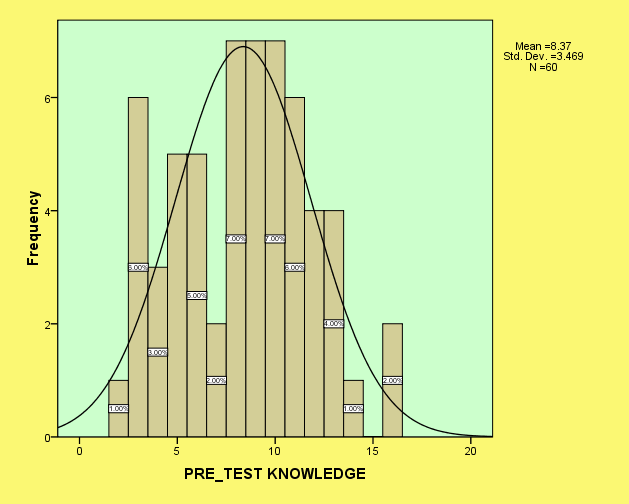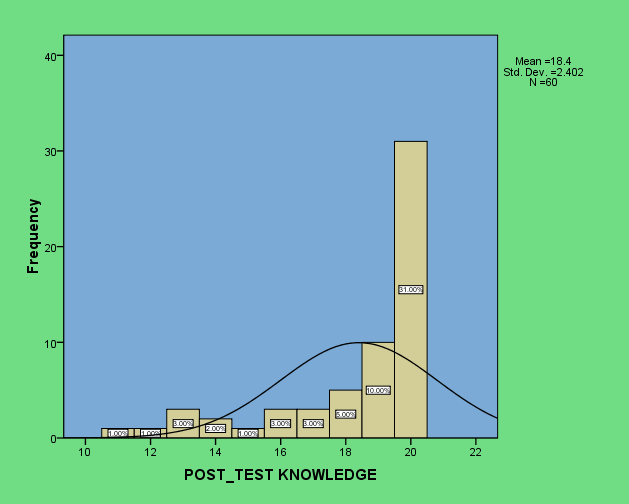Ijraset Journal For Research in Applied Science and Engineering Technology
- Home / Ijraset
- On This Page
- Abstract
- Introduction
- Conclusion
- References
- Copyright
Effect of Structured Teaching Programme on Knowledge regarding Preconception Care among Reproductive women under Mukalmua Block PHC, Nalbari district, Assam
Authors: Aisha Begum, Dr. Enu Boro, Mrs. Gayatri Baishya
DOI Link: https://doi.org/10.22214/ijraset.2024.64363
Certificate: View Certificate
Abstract
Background: Preconception care is a set of interventions that aim to identify and modify biomedical, behavioral, and social risks to a woman’s health or pregnancy outcome through prevention and management. The main goal of preconception care is to provide health promotion, screening and interventions for women of reproductive age to reduce the risk factor that might affect future pregnancies. Methodology: The research approach used for the study was quantitative evaluative research approach. The conceptual framework for the study was based on ‘General Systems Theory’ developed by Ludwig von Bertalanffy and modified by JW Kenny. A pre-experimental one-group pre-test post-test research design was used to evaluate the knowledge regarding preconception care among reproductive women. Multistage random sampling technique was used to select 60 reproductive women. Structured interview schedule was used to evaluate the knowledge regarding preconception care among reproductive women. Descriptive and inferential statistics were used to analyze the study data. Result: Findings revealed that out of 60 reproductive women; in the pre-test, majority 39(65%) of the participants had moderately adequate knowledge; 16(26.7%) of the participants had inadequate knowledge and only 5(8.3%) of the participants had adequate knowledge whereas in post-test, majority 53(88.3%) of the participants had adequate knowledge, only 7 (11.7%) had moderately adequate knowledge and none of them had inadequate knowledge regarding preconception care. The mean post-test knowledge scores 18.40 was significantly higher than the mean pre-test knowledge score 8.37 with mean difference 10.03 and \'t\' value 26.69 for df 59 at p< 0.05 level of significance. Socio-demographic variables such as educational status and use of contraceptive methods were found to be statistically significant at p<0.05 with pre-test level of knowledge regarding preconception care among reproductive women. Conclusion: On the basis of the findings, the study concluded that the structured teaching programme was an effective intervention in improving knowledge regarding preconception care among reproductive women.
Introduction
I. INTRODUCTION
To achieve good maternal and fetal outcome, healthcare to a woman has to start before she conceives. Candidates for adverse pregnancy outcomes are those who are unaware of the importance of preconception care (PCC). Healthcare providers need to assess actual and potential modifiable health risks both in rural and urban settings.1The preparation ideally should occur for at least three months prior to pregnancy. The components of preconception care include health promotion, assessment of risk factors, physical examination and laboratory studies.2One of the six pillars of the Indian Newborn Action Plan is promoting preconception care. 68.29% of couples had one or more preconception risk factors according to National Preconception Health Care Project. Hence, there is an urgent need to educate the community about preconception care and provide preconception care services to prevent maternal and newborn mortality.3
A. Statement of the Problem
“Effect of Structured Teaching Programme on Knowledge regarding Preconception Care among Reproductive women under Mukalmua Block PHC, Nalbari district, Assam.”
B. Specific Objectives
- To assess the pre-test and post-test level of knowledge regarding preconception care among reproductive women.
- To evaluate the effect of structured teaching programme on level of knowledge regarding preconception care among reproductive women.
- To find out the association between pre-test level of knowledge regarding preconception care among reproductive women with their selected socio-demographic variables.
C. Hypotheses
- H1: There is a significant difference between the pre-test and post-test level of knowledge regarding preconception care among reproductive women.
- H2: There is a significant association between the pre-test level of knowledge regarding preconception care among reproductive women with selected socio-demographic variables.
II. RESEARCH METHODOLOGY
- Research Approach: Quantitative evaluative research approach was selected for the present research study.
- Research Design: Pre-experimental one group pre-test and post-test design
- Research Setting: The study was conducted under Mukalmua Block PHC, Nalbari district, Assam.
- Population: Reproductive women under Mukalmua Block PHC, Nalbari district, Assam.
- Sample Size: 60 reproductive women
- Sampling Technique: Probability Multistage Random sampling technique
- Independent variable: Structured Teaching Programme on knowledge regarding preconception care
- Dependent variable: Knowledge of reproductive women on preconception care
- Demographic Variables: Age, religion, educational status, type of family, occupation, family income per month, use of contraceptive methods, menstrual cycle
- Tool: Socio-demographic proforma and Structured knowledge questionnaire on preconception care
|
SCORING CRITERIA |
SCORE |
LEVEL OF KNOWLEDGE |
|
Below 25th percentile |
0-4 |
Inadequate Knowledge |
|
25th-75th percentile |
5-15 |
Moderately Adequate Knowledge |
|
Above 75th percentile |
16-20 |
Adequate Knowledge |
- Reliability of the Tool: The Cronbach’s alpha method was used to calculate the reliability of the knowledge questionnaire. The reliability co-efficient of tool ‘r’ was found to be 0.730.
- Data Analysis and Interpretation: Descriptive and inferential statistics in terms of frequency, percentage, mean and standard deviation, Paired “t” test, Chi-square test and Fisher’s exact test.
III. ANALYSIS AND INTERPRETATION OF DATA
A. Findings related to socio-demographic data of the reproductive women
Table 1: Frequency and percentage distribution of socio-demographic data of the reproductive women
n?60
|
Sl No |
Demographic Variables |
Frequency (f) |
Percentage (%) |
|
1. |
Age in Years 18-21 22-29 30-39 |
15 37 8 |
25 61.7 13.3 |
|
2. |
Religion Hinduism Islam
|
19 41 |
31.7 68.3 |
|
3. |
Educational Status No formal education Primary education Secondary education Higher secondary Graduate and above |
5 10 17 21 7 |
8.3 16.7 28.3 35 11.7 |
|
4. |
Type of Family Nuclear family Joint family Extended family |
19 28 13 |
31.7 46.6 21.7 |
|
5. |
Occupation Government employee Private job Business Agriculture Home maker Others |
3 9 7 10 21 10 |
5 15 11.6 16.7 35 16.7 |
|
6. |
Family Income Per Month in Rupees 46,095-68,961 27,654-46,089 9,232-27,648 ≤ 9,226 |
6 16 37 1 |
10 26.7 61.6 1.7 |
|
7. |
Use of Contraceptive Methods Yes No |
47 13 |
78.3 21.7 |
|
8. |
Menstrual Cycle 25-27 days 28-30 days 31-33 days Irregular |
4 36 15 5 |
6.7 60 25 8.3 |
Table 1 depicts frequency and percentage distribution of demographic variables of the reproductive women. Results revealed that majority 37 (61.7%) of the participants belonged in age group 22-29, majority 41 (68.3%) of the participants belonged to Islam religion, majority 21 (35%) of the participants had higher secondary education, majority 28 (46.6%) of the participants belonged to joint type of family, majority 21 (35%) of the participants were home maker, majority 37 (61.6%) of the participants had family income per month in the range of 9,232-27,648; majority 47 (78.3%) of the participants used contraceptive methods and majority 36 (60%) of the participants had menstrual cycle in a period of 28-30 days.
B. Findings related to Pre-Test and Post-Test level of Knowledge regarding Preconception Care among Reproductive women
Table 2: Frequency and Percentage distribution of Pre-Test and Post-Test level of Knowledge regarding Preconception Care among Reproductive women
n=60
|
Level of Knowledge |
Pre-Test |
Post-Test |
||
|
f |
% |
f |
% |
|
|
Inadequate Knowledge |
16 |
26.7 |
0 |
0 |
|
Moderately Adequate Knowledge |
39 |
65 |
7 |
11.7 |
|
Adequate Knowledge |
5 |
8.3 |
53 |
88.3 |
|
Total |
60 |
100 |
60 |
100 |
Table 2 depicts the frequency and percentage distribution of pre-test and post-test level of knowledge regarding preconception care among reproductive women. Results revealed that in pre-test majority 39 (65%) of the participants had moderately adequate knowledge regarding preconception care; 16 (26.7%) of the participants had inadequate knowledge regarding preconception care and only 5 (8.3%) of the participants had adequate knowledge regarding preconception care. While in post-test majority 53 (88.3%) of the participants had adequate knowledge regarding preconception care and 7 (11.7%) of the participants had moderately adequate knowledge regarding preconception care and none of the participants had inadequate knowledge regarding preconception care.
C. Findings related to Histogram and Normal Probability Curve

Figure 1: Histogram and Normal Probability Curve showing
Pre-Test Knowledge of Reproductive women

Figure 2: Histogram and Normal Probability Curve showing
Post-Test Knowledge of Reproductive women
E. Findings related to Effect of Structured Teaching Programme (STP) on Knowledge regarding Preconception Care among Reproductive women
Table 3: Effect of Structured Teaching Programme on Knowledge regarding Preconception Care among Reproductive women
n=60
|
Comparison of Level of Knowledge |
Mean |
SD |
Mean Difference |
t Test Value |
df |
p Value |
|
Pre-Test |
8.37 |
3.469 |
10.03 |
26.69 |
59 |
0.001** |
|
Post-Test |
18.40 |
2.401 |
*p<0.05 level of significance NS-Non significant
Table 3 depicts the effect of structured teaching programme on knowledge regarding preconception care among reproductive women. Findings showed that pre-test mean knowledge score was 8.37±3.469 and post-test mean knowledge score was 18.40±2.401 with mean difference 10.03. The comparison was tested using paired t test with obtained (t=26.69) at df=59 was statistically significant at p<0.05 level. Findings revealed that structured teaching programme was effective in improving the knowledge regarding preconception care among reproductive women.
- Findings related to Association between Pre-Test Knowledge scores of Reproductive women regarding Preconception Care with their selected Socio-Demographic Variables
Table 4: Association between Pre-Test level of Knowledge regarding Preconception Care among Reproductive women with their selected Demographic Variables
n=60
|
SL NO
|
DEMOGR-APHIC VARIABL-ES |
PRE-TEST LEVEL OF KNOWLEDGE |
c2 VALUE/ FISHER’S EXACT TEST VALUE |
df |
P VA-LUE |
|||
|
INAD-EQUATE |
MODE-RATELY ADEQU-ATE |
ADE-QUATE |
||||||
|
1 |
Age in years 18-21 22-29 30-39 |
6 9 1 |
8 24 7 |
1 4 0 |
3.605
|
4 |
0.462NS
|
|
|
2 |
Religion Hinduism Islam |
7 9 |
11 28 |
1 4 |
1.610 |
2 |
0.447NS |
|
|
3 |
Educational status No formal education Primary education Secondary education Higher secondary Graduate and above |
5
10
1
0
0 |
0
0
15
19
5 |
0
0
1
2
2 |
32.04 |
8 |
0.001* |
|
|
4 |
Type of family Nuclear Joint Extended |
2 10 4 |
16 15 8 |
1 3 1 |
5.026
|
4 |
0.276NS
|
|
|
5 |
Occupation Government employee Private job Business Agriculture Home maker Others |
0
2 2 5 7 0 |
2
6 5 5 13 8 |
1
1 0 0 1 2 |
11.66 |
10 |
0.205NS |
|
|
6 |
Family income per month (in rupees) 46,095-68,961 27,654-46,089 9,232-27,648 ≤ 9,226 |
0
2
13 1 |
5
13
21 0 |
1
1
3 0 |
8.948
|
6 |
0.126NS |
|
|
7 |
Use of contracepti-ve methods Yes No |
9 7 |
34 5 |
4 1
|
6.404 |
2 |
0.041* |
|
|
|
Menstrual cycle 25-27 days 28-30 days 31-33 days Irregular |
0 8 5 3 |
4 23 10 2 |
0 5 0 0 |
6.312 |
6 |
0.312NS |
|
Table 4 depicts the association between pre-test level of knowledge regarding preconception care among reproductive women with their selected socio-demographic variables which was tested using chi-square test and Fisher’s exact test. Result revealed that socio-demographic variables such as educational status (Fisher’s exact test value?32.04; df?8; p?0.001), and use of contraceptive methods (c2 value?6.404; df?2; p?0.041) were found to be statistically significant at p<0.05 with pre-test level of knowledge regarding preconception care among reproductive women. Hence, research hypothesis H2 was accepted for educational status and use of contraceptive methods and null hypothesis H02 was rejected. However, no significant association was found between age, religion, type of family, occupation, family income per month and menstrual cycle at p<0.05 level with pre-test level of knowledge regarding preconception care among reproductive women. Therefore, the investigator rejected the research hypothesis H2 and accepted the formulated null hypothesis H02 for age, religion, type of family, occupation, family income per month and menstrual cycle.
Conclusion
The findings of the study revealed that in the pre-test, there was lack of knowledge regarding preconception care among reproductive women. After the administration of structured teaching programme majority of them had adequate knowledge regarding preconception care. On the basis of the findings, the study concluded that the structured teaching programme was an effective intervention in improving knowledge regarding preconception care among reproductive women.
References
[1] Raman AV. Maternity nursing: family, newborn, and women’s healthcare. 19th ed. New Delhi: Wolters Kluwer (India) Pvt. Ltd.; 2014. p. 35-36. [2] Bhaskar N. Midwifery and obstetrical nursing. 3rd ed. Bangalore: EMMESS Medical Publishers; 2019. p. 3, 14-17. [3] Doke PP, Gothankar JS, Pore PD, Palkar SH, Chutke AP, Patil AV, et.al. Meager perception of preconception care among women desiring pregnancy in rural areas: a qualitative study using focus group discussions. Front. Public Health. [internet]. 2021 Oct [cited 2023 January]; 9: 689820. Available from: URL: https://www.frontiersin.org/articles/10.3389/fpubh.2021.689820/full [4] Protect the promise: 2022 progress report on the Every Woman Every Child Global Strategy for Women’s, Children’s and Adolescents’ Health (2016–2030) [internet]. 2022 [cited 2023 June]; Available from: URL: https://www.unfpa.org/sites/default/files/pub-pdf/EWEC_Report_2022v2.pdf [5] Devi VS. Inderbir Singh’s human embryology. 13th ed. New Delhi: Jaypee Brothers Medical Publishers (P) Ltd; 2023. p. 84-99. [6] Special bulletin on maternal mortality in India 2018-20 [internet]. 2022 [cited 2023 September]; Available from: URL: https://censusindia.gov.in/nada/index.php/catalog/44379/download/48052/SRS_MMR_Bulletin_2018_2020.pdf [7] A neglected tragedy the global burden of stillbirths: report of the UN Inter-agency Group for Child Mortality Estimation, 2020 [internet]. 2020 [cited 2023 July]; Available from: URL: https://childmortality.org/wp-content/uploads/2020/10/UN-IGME-2020-Stillbirth-Report.pdf [8] Sharif N, Das B, Alam A. Prevalence of anemia among reproductive women in different social group in India: cross-sectional study using nationally representative data. PLoS One. [internet]. 2023 Feb [cited 2023 September]; 18(2): e0281015. Available from: URL: https://www.ncbi.nlm.nih.gov/pmc/articles/PMC9894404/ [9] Biradar RA. Anaemia status of preconception young married women in India. Journal of Biosocial Science. [internet]. 2022 Jul [cited 2023 July]; 54(4): 672-681. Available from: URL: https://www.cambridge.org/core/journals/journal-of-biosocial-science/article/abs/anaemia-status-of-preconception-young-married-women-in-india/569F3FB629737E280902264723F13CC
Copyright
Copyright © 2024 Aisha Begum, Dr. Enu Boro, Mrs. Gayatri Baishya. This is an open access article distributed under the Creative Commons Attribution License, which permits unrestricted use, distribution, and reproduction in any medium, provided the original work is properly cited.

Download Paper
Paper Id : IJRASET64363
Publish Date : 2024-09-27
ISSN : 2321-9653
Publisher Name : IJRASET
DOI Link : Click Here
 Submit Paper Online
Submit Paper Online

